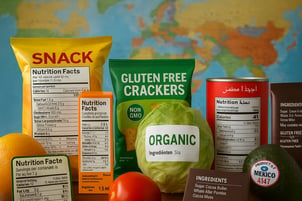Key Differences Between PIM and PLM Systems
The Cosmetics, Beauty and Personal Care industry is one of the most dynamic and vibrant industries, constantly evolving to meet the changing demands of the consumers. Think about it- from those ancient Egyptians and Greeks using cosmetics as part of their rituals, to the mass-produced cosmetics we saw in the 19th and 20th centuries. Like the first commercial lipstick being founded in the 1884 by a French company called Guerlain- the cosmetic industry has gone through massive changes. Now, this industry is huge in the global market, expected to hit $864.6 billion in sales by 2032.
Nowadays, people want more from every product, and cosmetics are no exception. They're looking for things that actually work, also are safe, and cause lesser harm to the planet. Now this has pushed the industry to get creative with how they make products, using emerging technologies like biotechnology, nano-emulsions, and supercritical extraction. These technologies are changing the scenario, leading to products that are better, gentler, and more eco-friendly.
Understanding the standard Cosmetics Product Development Process
The six basic steps to bring any product to the market are as follows:
Ideation
-
The initial stage involves the creation of a comprehensive product market brief, a document that outlines the business case, product specifications, and target audience.
-
This brief, while not containing all final details, should strive to be as complete as possible.
-
Given its role as a reference for multiple teams, the brief must provide information that facilitates the efficient execution of various stakeholder tasks.
Formulation Development
-
Leveraging the product brief as a foundation, R&D teams explore possibilities to achieve desired product specifications.
-
Identify and define the specs for right ingredients and materials of the formulation.
-
Scientists, Chemists and Pharmacists then undertakes the task of defining the product formulation, iterating on suitable ingredient with required levels.
Sourcing Materials
-
With a finalised product formula, the next step involves sourcing materials as per specifications for both the end-product.
-
While cost considerations are important, sustainability practices must also be looked after when evaluating vendors.
Packaging and Labelling Design
-
Define and gather storage and shelf life requirements. Understand the product shipping and transport requirements based on the regions.
-
Recognising the significant impact of packaging on consumer perception, this stage focuses on designing visually appealing and informative packaging.
-
Marketing and design teams collaborate to convey essential information, including use cases, appearance, and safety disclosures.
Quality and Compliance
-
To maintain brand reputation and customer satisfaction, rigorous quality testing of initial production runs are conducted.
-
Compliance assessments, including microbiological, toxicology, and stability testing and all necessary testing are performed to verify product safety.
-
Professionals must conduct thorough quality tests to ensure compliance with varying cross border regulations.
Product Validation
-
The final stage involves validating the product and obtaining all required internal and external approvals.
-
A comparison between the final product and the original product brief ensures alignment with established goals.
-
While changes are typically minimal at this stage, flexibility is maintained to preserve the integrity of the development process.
AS-IS Analysis
To make the most of cosmetic product development, you have to understand customer needs, products, and formulations.
A proper “AS-IS” analysis or you can also call it a current state analysis might help you in this. The key goals of this analysis are-
-
Identify the core and add on products, their appeal, and usage from consumer perspective.
-
Analyse the ingredients, sourcing strategies, quantify cost and complexity.
-
Gather the Formulations that supporting the products, application of new materials and technologies if any, regional compliances and more.
-
Capture the current packaging methods, requirements, storage conditions, labelling needs and standards.
TO-BE Vision
This process is just the continuation or pre-implementation phase of the AS-IS analysis. This analysis shows what heights you want your company to achieve in the future. This is a proposal, on behalf of your organisation, for the future. The key goals of this process would be:
-
Develop deep understanding of customer cohort to build a shopper centric growth plan. Identify white spaces to grow the portfolio.
-
Rationalise and build a portfolio of products. Say adding or removing product lines as needed based on shopper insights.
-
Reformulate to harmonise into product categories with identical core formulations and late-stage value additions.
-
Simplify ingredients by bringing down the fragmentation of raw materials, substances and packaging materials.
-
Optimise to reduce complexity, supply-chain costs and overheads.
-
Create transparency with compliances and good manufacturing practices.
Cosmetics, Beauty and Personal Care - a need for PLM?
In today's competitive market, cosmetics companies are under pressure to innovate, follow the regulations, and also make it cost effective. This is where PLM software for cosmetic brands becomes essential.
A PLM platform empowers R&D teams by providing a centralised repository for product information, enabling digital recording of materials, formula variation management, managing changed versions, and easier collaboration between all teams. PLM softwares have the capability to store and manage critical supplier information for future reference, ensuring the entire procedure efficiency. Also, PLM systems helps in idea sharing among stakeholders, fostering innovation. Finally, PLM systems document final product regulations for future reference, ensuring ongoing compliance through the shelf life of the product.
Visit Plevenn to have a clear understanding on how cloud PLM software products are helping the cosmetic product development procedure getting better.
Choosing the right PLM solution for your Cosmetic Product Development Needs
Cloud-based PLM is cheaper upfront, scales easily, and gets updates faster. But choosing the right PLM solution is very important. Think about these things:
-
How efficient is it for product development? The PLM system should make the entire production process smoother from start to finish.
-
Does it handle regulatory compliance well? It should be good at managing regulatory documents.
-
How well does it work with suppliers? It should make communication and data sharing easy.
-
Does it support quality control? It should help with testing and tracking defects.
-
Does it speed up time to market? It should streamline processes to get products out faster.
-
Is it easy to use? It should be intuitive.
-
Can it grow with your business? It definitely needs to be scalable.
To learn more about how Plevenn can be the right PLM solution for your cosmetic product development needs, visit us.
Final Thoughts
The cosmetics world is changing fast. Cosmetic product development software is becoming non-negotiable for businesses that want to stay ahead. They help improve efficiency, speed up launches, ensure compliance, support sustainability goals, and strengthen collaboration.
That's what Plevenn PLM offers, helping businesses tackle today's challenges and grab tomorrow's opportunities.
As technology gets better, PLM will be even more important in shaping the future of cosmetics.
Apr 2, 2025 6:08:57 PM








